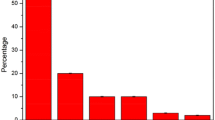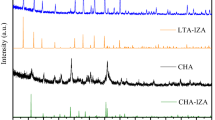Abstract
Regeneration of zeolite using microwave heating has been investigated focusing on the removal of toluene by desorption from zeolite samples. Studies were focused on the effect of physicochemical characteristics of three types of zeolite namely Na-rich natural zeolite (clinoptilolite), synthesized and heat treated on the toluene desorption ratio. In this work, it was shown that, in case of synthesized zeolite an increasing number of pores and their diffusion rate on the surface of samples caused by the sintering process resulted in an increase in the adsorption capacity compared to natural and heat-treated samples. The desorption experiment was carried out in MW irradiation time for about 1 h in which the temperature of zeolites samples was raised to almost 400 °C. Moisture had a significant effect on the desorption characteristics of zeolites. Maximum desorption ratios were obtained after approximately 30 min for heat-treated and synthesized samples when the moisture content was adjusted to 20 % of sample weight. In general, among the samples used in this study, synthesized zeolite showed the greatest absorption capacity and most efficient desorption ratio.










Similar content being viewed by others
References
Kim kJ, Ahn HG (2011) The effect of pore structure of zeolite on the adsorption of VOCs and their desorption properties by microwave heating. J Microporous Mesoporous Mater 152:78–83. doi:10.1016/j.micromeso.2011.11.051
Dehdashti A, Khavanin A, Rezaee A, Asilian H (2010) Regeneration of granular activated carbon saturated with gaseous toluene by microwave irradiation. Turk J Eng Environ Sci 34:49–58
Takamura Y, Narita S, Aoki J, Hironaka S, Uchida S (2001) Evaluation of dual-bed pressure swing adsorption for CO2 recovery from boiler exhaust gas. J Sep Purif Technol 24:519–528. doi:10.1016/S1383-5866(01)00151-4
Kikkinides ES, Yang RT, Cho SH (1993) Concentration and recovery of CO2 from flue gas by pressure swing adsorption. J Ind Eng Chem Res 32:2714–2720. doi:10.1021/ie00023a038
Merel J, Clausse M, Meunier F (2008) Experimental investigation on CO2 post-combustion capture by indirect thermal swing adsorption using 13X and 5A zeolites. J Ind Eng Chem Res 47:209–215. doi:10.1021/ie071012x
Nezamzadeh-Ejhieh A, Esmaeilian A (2012) Application of surfactant modified zeolite carbon paste electrode (SMZ-CPE) towards potentiometric determination of sulfate. Microporous Mesoporous Mater 147:302–309. doi:10.1016/j.micromeso.2011.06.026
Nezamzadeh-Ejhieh A, Nematollahi Z (2011) Surfactant modified zeolite carbon paste electrode (SMZ-CPE) as a nitrate elective electrode. Electrochim Acta 56:8334–8341. doi:10.1016/j.electacta.2011.07.013
Haque KE, Chen TT, Dutrizac JE, Wyslouzil W, Kashyap S (1984) The relative transparency of minerals to microwave radiation. J Can Metall Q 23:349–351
Ania CO, Parra JB, Menedez JA, Pis JJ (2005) Effect of microwave and conventional regeneration on the microporous and mesoporous network and on the adsorptive capacity of activated carbons. J Microporous Mesoporous Mater 85:7–15. doi:10.1016/j.micromeso.2005.06.013
Nezamzadeh-Ejhieh A, Khorsandi M (2010) Photo decolorization of Eriochrome Black T using NiS–P zeolite as a heterogeneous catalyst. J Hazard Mater 176:629–637. doi:10.1016/j.jhazmat.2009.11.077
Guisnet M, Gilson JP (2002) Zeolite for cleaner technologies. Imperical College Press, London, pp 301–310
Nezamzadeh-Ejhieh A, Hashemi HS (2011) Voltammetric determination of cysteine using carbon paste electrode modified with Co (II)–Y zeolite. Talanta 88:201–208. doi:10.1016/j.talanta.2011.10.032
Nezamzadeh-Ejhieh A, Kabiri-Samani M (2013) Effective removal of Ni(II) from aqueous solutions by modification of nano particles of clinoptilolite with dimethylglyoxime. J Hazard Mater 260:339–349. doi:10.1016/j.jhazmat.2013.05.014
Nezamzadeh-Ejhieh A, Moazzeni N (2013) Sunlight photodecolorization of a mixture of methyl orange and bromocresol green by CuS incorporated in a clinoptilolite zeolite as a heterogeneous catalyst. J Ind Eng Chem 19:1433–1442. doi:10.1016/j.jiec.2013.01.006
Caro J, Noack M, Kolsch P, Schafer R (2000) Zeolite membranes—state of their development and perspective. J Microporous Mesoporous Mater 38:3–24. doi:10.1016/S1387-1811(99)00295-4
Maesen T, Marcus B (2001) The zeolite scene—an overview. Stud Surf Sci Catal 137:1–9. doi:10.1016/S0167-2991(01)80242-1
McLeary EE, Jansen JC, Kapteijn F (2006) Zeolite based film, membranes and membrane reactor: progress and prospects. J Microporous Mesoporous Mater 90:198–220. doi:10.1016/j.micromeso.2005.10.050
Kawamura K, Endo H (1996) Preparation of porous alumina and its bending strength. J Ceram Soc Jpn 104:719–722
Chang DC, Hellring SD, Miale JN, Schmitt KD, Briqandi PW, Wu EL (1985) Insertion of aluminum into high-silica-content zeolite frameworks. Part 3. Hydrothermal transfer of aluminum from Al2O3 into [Al] ZSM-5 and [B] ZSM-5. J Chem Soc 81:2215–2224. doi:10.1039/F19858102215
Shihabi DS, Garwood WE, Chu P, Miale JN, Lago RM, Chu CTW, Chang DC (1985) Aluminum insertion into high-silica zeolite frameworks: II. Binder activation of high-silica ZSM-5. J Catal 93:471–474. doi:10.1016/0021-9517(85)90195-2
Ghadiri SK, Nabizadeh R, Mahvi AH, Nasseri S, Kazemian H, Mesdaghinia AR, Nazmara S (2010) Methyl tert-butyl ether adsorption on surfactant modified natural zeolites. Iran J Environ Health Sci Eng 7:241–252
Lin YC, Bai H (2006) Temperature effect on pore structure of nanostructured zeolite particles synthesized by aerosol spray method. Aerosol Air Qual Res 6:43–53
Chen KW, Davis HT, Davis EA, Gordon J (2004) Heat and mass transfer in water-laden sandstone. J Microw heat 31:842–848. doi:10.1002/aic.690310521
Menna RS, Bhattachrya S, Chatterjee R (2010) Development of “tuned microwave absorbers” using U-type hexaferrite. J Mater Des 31:3220–3226. doi:10.1016/j.matdes.2010.02.019
Wei J, Liu J, Li S (2007) Electromagnetic and microwave absorption properties of Fe3O4 magnetic films plated of hollow glass spheres. J Magn Magn Mater 312:414–417. doi:10.1016/j.jmmm.2006.11.128
Kurlyandskaya GV, Cunanan J, Bhagat SM, Aphesteguy JC, Jacoco SE (2007) Field-induced microwave absorption in Fe3O4 nanoparticles and Fe3O4/polyaniline composites synthesized by different methods. J Phys Chem Sol 68:1527–1532. doi:10.1016/j.jpcs.2007.03.031
Ohgushi T, Komarneni S, Bhalla AS (2001) Mechanism of microwave heating of zeolite A. J Porous Mater 8:23–37
Goto Y, Fukushima Y, Ratu P, Imada Y, Kubota Y, Sugi Y, Ogura M, Mjourna Matsukata (2002) Mesoporous materials from zeolite. J Porous Mater 19:43–49
Vassylyev OY, Hall GH, Khinast JG (2006) Modification of zeolite surface by Grgnard reagent. J Porous Mater 13:5–13
Li B, Wang L, Jin Q, Guo Z, Tang S, Ding D (2002) Theoretical studies of CDS clusters in zeolite Y. J Porous Mater 9:287–291
Van Heijnsbergen D, Von Helden G, Meijer G, Duncan MA (2002) Infrared resonance-enhanced multiphoton ionization spectroscopy of magnesium oxide clusters. J chem phys 116:2400–2408
Ertu˘grul I, Alime I (2007) Dielectric behavior of the catalyst zeolite NaY. Turk J Chem 31:523–530
Rahi GS, Rich JR (2011) Effect of moisture on efficiency of microwaves to control plant parasitic nematodes in soil. J Microw Power Electromagn Energy 45:86–93
Acknowledgments
This work was supported financially by the Environmental Engineering Department of Chonbuk National University in 2009. The authors also wish to acknowledge the Climate Change Specialization Graduate School program of Chonbuk National University for their cooperation.
Author information
Authors and Affiliations
Corresponding author
Rights and permissions
About this article
Cite this article
Yang, G.S. The effect of different moisture levels on the toluene desorption rates of modified natural zeolite during MW irradiation. J Mater Cycles Waste Manag 18, 113–122 (2016). https://doi.org/10.1007/s10163-014-0327-x
Received:
Accepted:
Published:
Issue Date:
DOI: https://doi.org/10.1007/s10163-014-0327-x




